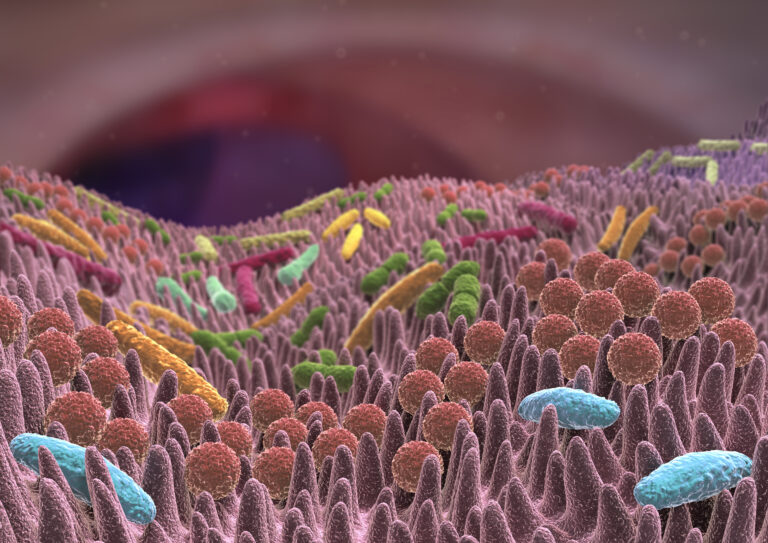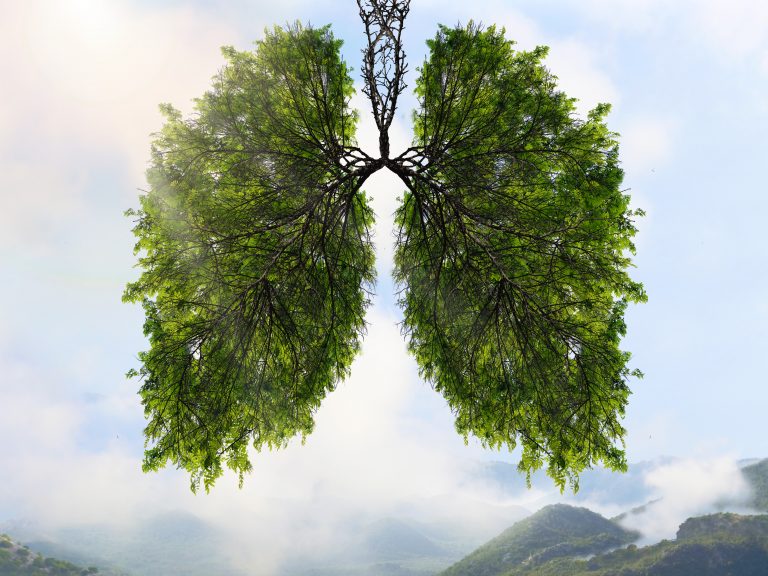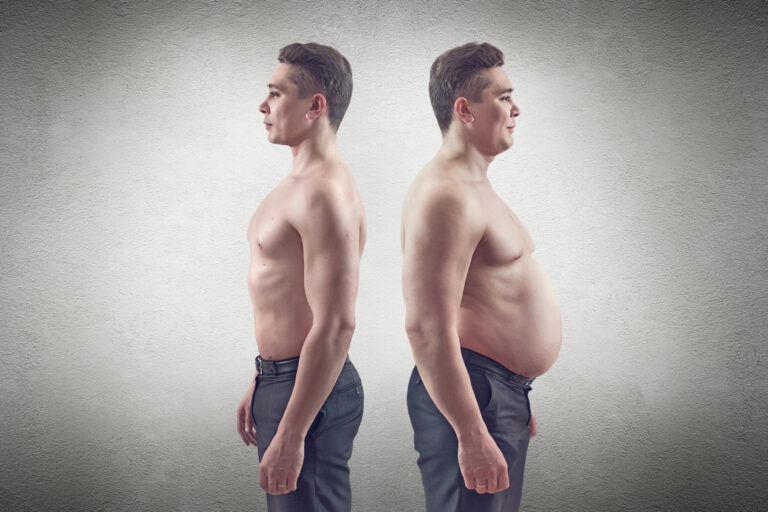
Naringenin und Covid-19
Das Flavanon Naringenin hat positive Wirkungen auf die Lunge und wurde schon als Mittel gegen Covid-19 getestet.
The yo-yo effect is an unwanted and rapid weight regain after a reduction diet. With repeated diets, body weight can move up and down like a yo-yo, with the new final weight often being higher than the starting weight [1]. So far, nothing could be done against the yo-yo effect and anyone who has had it before once or more often knows how frustrating it is. The good news is that it has nothing to do with genetic predisposition, as twin studies have shown [2], nor is it dependent on initial weight [3] or fitness level [4]. There is now evidence that the metabolic complications that lead to the yo-yo effect are anchored in the gut microbiome [5]. With weight gain, i.e. with a long-lasting diet rich in fat and sugar, the microbiome changes adversely. The metabolic balance is disturbed and a dysbiosis develops. After successful reduction diets, all other metabolic parameters, such as e.B fat metabolism, insulin levels or energy consumption, return to the normal initial state. Only the dysbiosis persists for several months (ca.15 weeks) [6]. If it comes back into contact with high-fat and high-sugar foods, the metabolic complications that lead to the yo-yo effect arise. 773 bacterial genes have been identified that have been upregulated in the microbiome as they gain weight and that consistently outlast any diet. These include genes that break down the healthy plant substances (flavonoids) in a way that is no longer usable for humans. The microbiome significantly reduces the flavanones naringenin and apigenin,whose metabolites have a decisive effect on metabolic balance by influencing fat metabolism, glucose tolerance and energy consumption [7,8,9].
As tips for avoiding the yo-yo effect, only a few unfeasible advice is available like: lose weight slowly and avoid crash diets or do a lot of sports and always stay on the move or at the best execute a lifelong change in your diet!
Der Sinn hinter den Ratschlägen ist eindeutig und beschreibt die Tatsache, dass man den Kalorienverbrauch so lange hoch halten soll, bis sich das Mikrobiom erholt hat. Dass diese Tipps nicht für jeden Abnehmwilligen durchführbar sind, ist leicht einzusehen. Mit der richtigen Zufuhr von mikrobiomaktiven Flavonoiden kann es viel schneller erreicht werden und es ist leicht in den Alltag integrierbar. Das Mikrobiom wird auf „schlank“ programmiert und unterstützt einen maximal bei der Kalorienverwertung. Für die meisten ist es ja kein Problem eine Diät zu machen. Nur das Dauerhafte ist für viele nicht durchführbar. Wenn man den Diäterfolg absichern kann und wenigsten ein paar Kilo verliert, tut man seinem Körper ja schon viel Gutes.
Der intestinale Flavonoidgehalt ist durch zwei Begebenheiten unterdurchschnittlich niedrig. Zum einen wird bei der Gewichtszunahme als auch bei der diätischen Reduktionskost viel zu wenig von den Pflanzenstoffen zu sich genommen und zusätzlich sorgt das dysbiotische Mikrobiom für einen erhöhten Abbau der gesunden Pflanzenstoffe. Kurios ist, dass sogar Diäten selber zu einem nachteilig verschobenen Mikrobiom führen können [10]. Überspitzt bedeutet das: Je konsequenter man hungert, desto weniger erfolgsversprechend können Diäten sein [11]. Trotzdem sind Diäten aber nach wie vor notwendig. Diät heißt dabei lediglich, weniger Kalorien zu sich zu nehmen als man verbraucht. Deshalb sollte man bereits diätbegleitend auf das Mikrobiom einwirken [12,13], um den Verbrauch hoch zu halten [14,15,16]. In Zeiten des Mangels sollten die Flavanone Naringenin und Apigenin dem Darm durch eine spezielle Verkapselung zugeführt werden, da sie sonst im Körper über den Phase-II-Metabolismus verstoffwechselt werden [17,18]. Aufgrund ihrer hohen Unlöslichkeit werden die wichtigen Stoffe einfach ausgeschieden und können nicht dort wirken, wo am dringendsten benötigt werden. Sie haben eine sehr schlechte Bioverfügbarkeit. Das Problem der mangelnden Bioverfügbarkeit ist gelöst, wenn man es dem Darmmikrobiom bioverfügbar macht, um in den Genuss der diversen gesundheitsfördernden Eigenschaften zu kommen [19].
[1] Seite „Jo-Jo-Effekt“. In: Wikipedia, Die freie Enzyklopädie. Bearbeitungsstand: 2. Dezember 2019, 08:22 UTC. URL: https://de.wikipedia.org/w/index.php?title=Jo-Jo-Effekt&oldid=194562039 (Abgerufen: 20. März 2020, 12:32 UTC)
[2] Pietiläinen, K. H. et al. Does dieting make you fat? A twin study. Int. J. Obes. (2012), 3: 456–464.
[3] Neumark-Sztainer, D. et al. Obesity, disordered eating, and eating disorders in a longitudinal study of adolescents: how do dietersarfe 5 years later? J. Am.Diet. Assoc. (2006),106: 559–568.
[4] Saarni, S. E. et al. Weight cycling of athletes and subsequent weight gain in middleage. Int. J. Obes. (2006), 30: 1639–1644.
[5] Chilloux J. and Dumas ME. Are gut microbes responsible for post-dieting weight rebound? Cell Metab (2017),25: 6–7.
[6] Thaiss et al. Persistent microbiome alterations modulate the rate of post-dieting weight regain. Nature (2016), 540: 22-29.
[7] Jung, U.J. et al. Naringin supplementation lowers plasma lipids and enhances erythrocyte antioxidant enzyme activities in hypercholesterolemic subjects. Clin. Nutr. (2003), 22: 561–568.
[8] Mollace, V. et al. Hypolipemic and hypoglycaemic activity of bergamot polyphenols: From animal models to human studies. Fitoterapia (2011), 82: 309–316.
[9] Oteiza P.I. et al. Flavonoids and the gastrointestinal tract: local and systemic effects. Mol Aspects Med (2018), 61: 41-49.
[10] Seganfredo F. B., et al. Weight-loss interventions and gut microbiota changes in overweight and obese patients: a systematic review. Obesity Reviews (2017), 18(8): 832–851.
[11] Hill, A.J. Does dieting make you fat? Br. J. Nutr. (2004) 92: 15–18.
[12] Heinsen F.A. et al. Beneficial Effects of a Dietary Weight Loss Intervention on Human Gut Microbiome Diversity and Metabolism Are Not Sustained during Weight Maintenance. Obes Facts (2016), 9: 379–391.
[13] Sivamaruthi B. S. et al. A Review on Role of Microbiome in Obesity and Antiobesity Properties of Probiotic Supplements. BioMed Research International (2019), Article ID 3291367: 20 pages.
[14] Turnbaugh, P. J. et al. An obesity-associated gut microbiome with increased capacity for energy harvest. Nature (2006), 444: 1027–1031.
[15] Ridaura, V. K. et al. Gut microbiota from twins discordant for obesity modulate metabolism in mice. Science (2013), 341: 1241214.
[16] Ley, R. E. Obesity and the human microbiome. Curr. Opin. Gastroenterol. (2010), 26: 5–11.
[17] Hu, M. et al. Bioavailability of Polyphenols and Flavonoids in the Era of Precision Medicine. Mol Pharm. (2017),14(9): 2861-2863.
[18] Kanaze F. I. et al. Pharmacokinetics of the citrus flavanone aglycones hesperetin and naringenin after single oral administration in human subjects. European Journal of Clinical Nutrition (2007), 61: 472–477.
[19] Direito, R. et al. Phenolic Compounds Impact on Rheumatoid Arthritis, Inflammatory Bowel Disease and Microbiota Modulation. Pharmaceutics (2021), 13(2): 145.

Das Flavanon Naringenin hat positive Wirkungen auf die Lunge und wurde schon als Mittel gegen Covid-19 getestet.

Das Mikrobiom mischt bei Demenz, Autismus und Herzinfarkten mit. Billionen Bewohner des Verdauungstrakts werden künftig zu Therapeuten.

Die Lunge profitiert von antioxidativen und antiinflammatorischen Pflanzenstoffen.

Das Flavanon Naringenin hat positive Wirkungen auf die Lunge und wurde schon als Mittel gegen Covid-19 getestet.

Das Mikrobiom mischt bei Demenz, Autismus und Herzinfarkten mit. Billionen Bewohner des Verdauungstrakts werden künftig zu Therapeuten.

Die Lunge profitiert von antioxidativen und antiinflammatorischen Pflanzenstoffen.

80% aller Hungerkuren scheitern. Um der Statistik des Scheitern entgegenzuwirken, gibt es jetzt etwas gegen den Jo-Jo-Effekt aber auch ein paar grundsätzliche Dinge sollten beachtet werden.
| Cookie | Dauer | Beschreibung |
|---|---|---|
| cookielawinfo-checbox-analytics | 11 months | This cookie is set by GDPR Cookie Consent plugin. The cookie is used to store the user consent for the cookies in the category "Analytics". |
| cookielawinfo-checbox-functional | 11 months | The cookie is set by GDPR cookie consent to record the user consent for the cookies in the category "Functional". |
| cookielawinfo-checbox-others | 11 months | This cookie is set by GDPR Cookie Consent plugin. The cookie is used to store the user consent for the cookies in the category "Other. |
| cookielawinfo-checkbox-necessary | 11 months | This cookie is set by GDPR Cookie Consent plugin. The cookies is used to store the user consent for the cookies in the category "Necessary". |
| cookielawinfo-checkbox-performance | 11 months | This cookie is set by GDPR Cookie Consent plugin. The cookie is used to store the user consent for the cookies in the category "Performance". |
| viewed_cookie_policy | 11 months | The cookie is set by the GDPR Cookie Consent plugin and is used to store whether or not user has consented to the use of cookies. It does not store any personal data. |